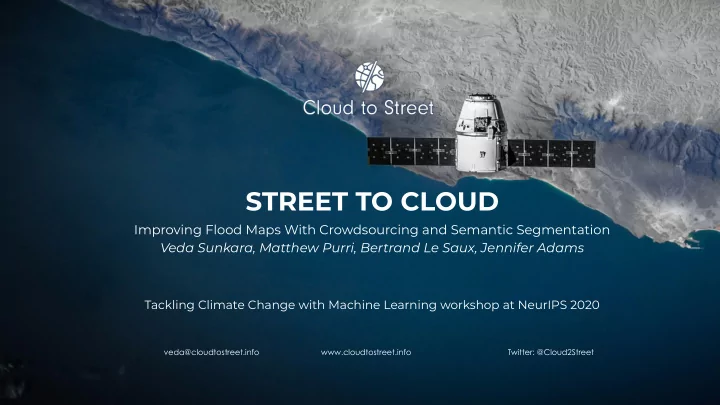

STREET TO CLOUD Improving Flood Maps With Crowdsourcing and Semantic Segmentation Veda Sunkara, Matthew Purri, Bertrand Le Saux, Jennifer Adams Tackling Climate Change with Machine Learning workshop at NeurIPS 2020 veda@cloudtostreet.info www.cloudtostreet.info Twitter: @Cloud2Street
NEED Near Real Time Flood Mapping Rising frequency and magnitude of flood disasters (UNDRR 2015) Growing populations affected, disproportionate impacts due to social vulnerability (Tellman et. al. 2020)
THE SCIENCE Satellite Imagery, Remote Sensing, and ML maps made from optical, radar, and microwave satellites Nowcast flood extents and impactes → disaster relief [Bonafilia, et. al. 2020]
CHALLENGES WITH SATELLITE IMAGERY ● Infrequent revisit times ● Varying resolutions Adverse weather conditions ● ● Lack of precision in urban areas ● Unlikely to capture flood peak
LIMITATIONS OF EXISTING TECHNIQUES ● Manual thresholding and quality assurance Availability of training data ●
SOLUTION: CROWDSOURCING Simplified training labels, multimodal network, community engagement
METHODOLOGY: TRAINING LABELS 1. reference: fine, hand labeled flood masks (Sen1Floods11) 2. Coarse, simplified flood masks (Gaussian blur of Sen1Floods11)
METHODOLOGY: CROWDSOURCED DATA POINTS PERIMETER DATA POINTS Two strategies to collect street information: 1. Social media scraping (low dispersion) 2. Trained data collector (high dispersion)
METHODOLOGY: TRAINING
RESULTS Gains in accuracy and mIoU over coarse labels, fine labels in single input architecture
RESULTS Gains with any crowdsourcing form, with the best results from the trained data collector simulation (high dispersion) with low noise.
FUTURE WORK Crowdsourcing viability ● Sensitivity analysis ● Unsupervised/weakly supervised training ● Case study on urban areas ● HIGH-RESOLUTION IMAGERY OF MAKOTIPOKO, SKYSAT SATELLITE 2019, PLANET LABS
Thank you. Questions? Contact veda@cloudtostreet.info
Recommend
More recommend